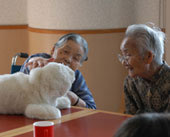
health
Living With Bots May Not Be As Bad As It Sounds
If you haven’t thought about a robot washing your butt or  being your cuddly companion, it might be time to give it some serious consideration. Looking ahead a few years to when 28% of its population will be over 65, Japan is pinning its hopes on robotics to fill the shortfall in caregivers for the elderly.
being your cuddly companion, it might be time to give it some serious consideration. Looking ahead a few years to when 28% of its population will be over 65, Japan is pinning its hopes on robotics to fill the shortfall in caregivers for the elderly.
It seems like Japan has always been gaga for bots, but now you can begin to understand the logic behind the passion. With a declining birthrate, older citizens living longer, and an overall population that declined in 2005 (the first decline since the end of World War II), Japan is serious about robotics as an eldercare solution.
It sounds bizarre at first, but there are many ways in which robots could supplement human care. For example, a robot could be programmed to schedule and deliver medicine at the appropriate times, or to send out an alert if a patient has fallen, and even monitor vital signs until medical help arrives. Sanyo Electric has come out with a robotic bathtub that encloses a patient in a wheelchair and then initiates a wash and rinsce cycle. It sounds a little bit like a carwash and  that was the actual inspiration. A health aide still shampoos and drys the hair, but the most labor intensive aspect of nursing home operations can be handled by the robot.
that was the actual inspiration. A health aide still shampoos and drys the hair, but the most labor intensive aspect of nursing home operations can be handled by the robot.
While your instincts may be telling you this is all very impersonal, maybe it’s time to rethink the problem. Maybe getting your butt washed by a robot is better than having someone do it for you, and sitting inside a mini carwash could be the highlight of your day. Some anecdotal evidence indicates that elderly patients can respond well to the robots. One observer witnessed nursing home patients in Nanto City Japan sitting in a community room vacantly staring out the window or impassively watching a television screen. The moment the robotic pet seal Paro is brought into the room, the patients’ faces light up and they all wanted to interact with the furry robot.  Preliminary studies indicate that robot interaction lowered stress, elevated moods and decreased depression. The presence of Paro increased social interaction and even the caretakers found that it made it easier to interact and converse with patients.
Preliminary studies indicate that robot interaction lowered stress, elevated moods and decreased depression. The presence of Paro increased social interaction and even the caretakers found that it made it easier to interact and converse with patients.
If all of this sounds impressive, think about the fact that the demand for eldercare robots is expected to boost the personal robot biz into a $40 billion industry by 2025. That means that besides meeting the gap in eldercare workers, robotics could just be pretty darn profitable. So besides looking ahead to the day when R2D2 gives you a bath, now might be a good time to invest in the robotics industry. That way you can have a private room at the very best nursing home money can buy.
Jay Harrison is a graphic designer and writer whose work can be seen at DesignConcept. He's written a mystery novel, which therefore makes him a pre-published author.
© 2006-2013 ConceptDesign, Inc. Terms of Use
BoomSpeak - For babyboomers - by babyboomers.